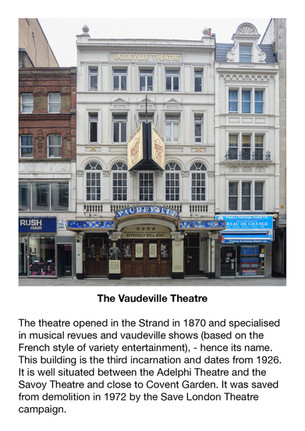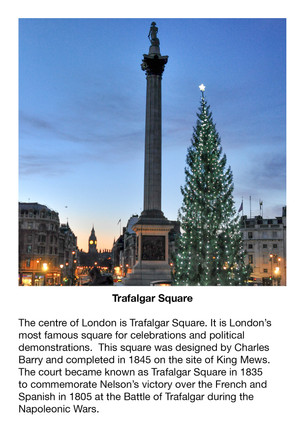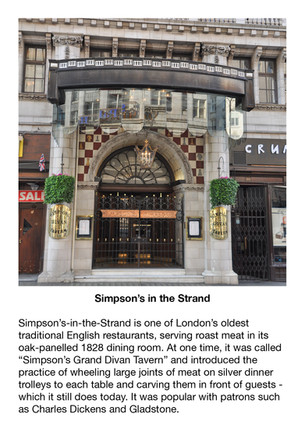L7 - Discover London’s Eastern Theatre District - from Covent Garden to the Strand (1.8 km)
- philip carey

- Aug 22, 2022
- 8 min read
Updated: Dec 22, 2024
Start at Covent Garden Station
Finish at Trafalgar Square (near Charing Cross Station)

THE EXPERIENCE
Just as theatre is the ‘art of looking at ourselves', this route through Covent Garden and the Strand will help you with the art of looking at London and understanding how the area evolved to become one of the most important entertainment regions in London from the 1660s onwards.
It is great for its atmosphere, history, iconic sights, entertainment venues, crowds, transport links, shops, theatres, museums, art galleries, and lots of places to eat, drink, and be merry.

MUST SEE PLACES

What to See List
1. Covent Garden Market Building
2. The Transport Museum
3. Theatres along Catherine Street
4. The Aldwych and the Waldorf
5. Somerset House
6. The Savoy Hotel and Theatre
7. The Strand
8. St Martin-in-the-Fields Church
9. The National and Portrait Gallery
10. Trafalgar Square & Nelson’s Column
PLACES TO EAT, DRINK AND BE MERRY

Areas to Eat, Drink and Be Merry List
1. The Northern End of Whitehall
2. Around Villiers Street
3. Around St Martin’s Lane
4. Around the Savoy
5. Around Wellington Street
6. Catherine Street & the Aldwych
7. Around Russel Street
8. Around Covent Garden Piazza
9. Around Maiden Lane
10. Along Neal’s Yard
Links to nearby Eat, Drink and Be Merry Routes.
Covent Garden – Start at Covent Garden and finish at Leicester Square
https://www.photoruns.com/post/covent-garden-shopping-eat-drink-and-be-merry-photorun
St Giles - Start at Leicester Square and end at Covent Garden
https://www.photoruns.com/post/st-giles-entertainment-area-eat-drink-and-be-merry-photorun
Around the Centre of London – Start and end at Charing Cross Station
https://www.photoruns.com/post/centre-of-london-sightseeing-eat-drink-and-be-merry-photorun
BEST TIME
Morning - The best time to do this route is on weekends in the early morning when it is quiet and free from crowds and heavy traffic.
Day - Most of the route will be busy during the day.
Evenings - Covent Garden and the Strand will be busy during the evening.
ROUTE OVERVIEW
This 1.8 Km route begins at Covent Garden, where the west end entertainment zone was born. It traces the path down past historic theatres and great places to eat and drink before emerging at the Aldwych and then the Strand by Somerset House. The route travels the length of the Strand past the Savoy and Charing Cross before ending up on the south side of Trafalgar Square.
Route at a Glance Video..
These links open in a new tab
DESCRIPTIVE PHOTO GALLERY
This gallery provides a descriptive and visual reference to many sights along this route. Use the Google Map above to find their location. Double-click to see its full size.
INTERESTING FACTS
Covent Garden Market
The first historical record of Covent Garden dates back to 1200 when it consisted of fields. In the 1500s, it was known as the ‘Convent Garden’ as it grew vegetables for the monks at Westminster Abbey. Once the area was developed in the 1600s, the square became an ideal place for a market. Unfortunately, when the sun went down, it became notorious for its nightlife market. The aristocracy who lived around the square could not handle the combined market chaos, nightlife and theatre scene and left the area. As they did so, the working class moved into Seven Dials and the nearby St Giles, and these areas quickly became overcrowded and suffered from poverty and dilapidation.
In 1828, the architect Charles Fowler was commissioned to design the neo-classical Market Building to provide a formal market area, reinstate order in the area, and establish Covent Garden as the primary market for vegetables and flowers. Although the market moved to its new site in Nine Elms in Battersea (called New Covent Garden), the Market Building and many surrounding properties have remained. There are plenty of eat, drink and be merry places both in and around the Market Building, with most being on the eastern and southern sides.
Royal Opera House - Bow Street
The Royal Opera House is often referred to as Theatre Royal Covent Garden as this was the name when Charles II founded it in 1662. It is renowned for its traditional opera performance and for commissioning new works by today’s leading opera composers. This is the third theatre on the site and dates from 1858 and became the Royal Opera House in 1892. It briefly became a dance hall during World War II before returning to opera and ballet.
The Royal Opera House stretches from Russell Street to Floral Street along Bow Street. The arched entrance near Russell Street is the revamped Paul Hamlyn Hall, called the Floral Hall, and was built in 1860. The new Linbury Theatre has been made at the lower level by Russell Street with a new restaurant, bar, and terrace at the amphitheatre level, giving visitors spectacular views over Covent Garden.
Bow Street Magistrates’ Court was established in 1740 and is famous for the creation of the Bow Street Runner – a private police force that cleaned up the area n the Gin Craze in 1748 – and the Bow Street Magistrates’ Court was used to bring quick prosecutions to those arrested and housed the local police force. This current building dates from 1879 and was used by the Metropolitan Police Station until 1992. Today, the building is a NoMad Hotel, with the Bow Street Police Museum on its southern edge.
Theatre Royal Drury Lane - Catherine Street
The Theatre Royal Drury Lane has been entertaining the public since 1663 when Charles II re-established the theatre following the Restoration of the Monarchy in 1660. It is the world’s oldest theatre that is still in continuous use, and this building dates from 1812.
Every reigning monarch has visited the theatre since the Restoration of 1660, and the two sides of the theatre are named King’s Side and Prince’s Side. It is also one of the world’s most haunted theatres, the most famous ghost being the Man in Grey, who appears during matinees.
Catherine Street is named after Queen Catherine of Braganza, wife of King Charles II.
Strand Facts
Strand (or the Strand) runs just over 1.2 km from Trafalgar Square eastwards, through part of London's West End theatreland, to Temple Bar, where the road becomes Fleet Street.
In the Middle Ages, Westminster was separated from Old London by fields, and the Strand was the main road that linked them. The Strand was popular with the British upper classes between the 12th and the Strand became well known for its coffee shops, restaurants and taverns. It also became an area rich in theatres and music halls during the 19th century.
Strand was the first road in London to have a numbered address. The official residence of the Secretary of State used to be in a building on the thoroughfare and, during the reign of Charles II (between 1660 and 1685), it became known as No 1., The Strand — the first building in London to have a street number.
There have been two Underground stations called Strand, neither of which are still in use today:
There are/were two separate stations called Strand, though both are no longer in active use. One was at the end of a short branch of the Piccadilly line and was renamed to Aldwych in 1915, whilst the other was on the Northern Line and was subsequently merged with another nearby station called Trafalgar Square in 1973 to form what is now know as Charing Cross
The Exeter Exchange (or Exeter 'Change) was a menagerie which was situated on the north side of Strand from 1773 until 1829. Its name comes from Exeter House, which previously stood on the site of the menagerie. Tigers, hyenas, lions, jaguars and sloths were among the many animals who passed through the menagerie — no mean feat considering it was contained to the upper floors of the building. But the most famous animal was Chunee, an elephant who arrived in 1809, and earned his keep by performing on stage at Theatre Royal in Covent Garden.
As was common at the time, animal welfare was not a priority and Chunee developed a rotten tusk, which was left untreated, making him so irritable that he was killed by soldiers from Somerset House in 1826.
The road's name comes from the Old English strong, meaning the edge of a river. The street was much identified with the British upper classes between the 12th and 17th centuries, with many historically important mansions being built between the Strand and the river. These included Essex House, Arundel House, Somerset House, Savoy Palace, Durham House and Cecil House. The aristocracy moved to the West End during the 17th century, and the Strand became known for its coffee shops, restaurants and taverns.
Savoy Palace was the London residence of John of Gaunt, King Richard II's uncle and the nation's power broker. In the 14th century the Savoy was the most magnificent nobleman's mansion in England. During the Peasants' Revoltof 1381, rebels, led by Wat Tyler, inflamed by opposition to the poll tax promoted by John of Gaunt, systematically demolished the Savoy and everything in it. In 1512 it was rebuilt as the Savoy Hospital for the poor. It gradually fell into dereliction and was divided into multiple tenancies. It was demolished in 1816–20 to build the approach road to Waterloo Bridge. eventually being demolished in the 19th century. The Savoy Hotel now occupies this site
Trafalgar Square
Trafalgar Square is considered the centre of London and is London’s most famous square for celebrations and political demonstrations. This square was designed by Charles Barry and completed in 1845 on the site of the King’s Mews. The square became known as Trafalgar Square to commemorate Nelson’s victory over the French and Spanish in 1805 at the Battle of Trafalgar during the Napoleonic Wars. A Christmas tree has been donated to the square by Norway since 1947 and is erected for twelve days before and after Christmas Day.
Nelson’s Column
This commemorates Lord Nelson’s (Viscount Horatio Nelson) victory at the Battle of Trafalgar in 1812. The 44-metre-high column was erected in 1843. The bronze reliefs at the bottom were made from cannons captured during the battle. William Railton designed Nelson's Column. The statue of Nelson was by E. H. Baily, and Edwin Landseer added the bronze lions in 1867.
King Charles island – The True Centre of London
The statue of King Charles I by the French sculptor Hubert Le Sueur was initially located here in 1633, but after the Parliamentary victory in the English Civil War, the statue was sold for scrap, but instead, it was buried for safekeeping. King Charles I was beheaded in 1649 outside Banqueting Hall in Whitehall. After the Restoration, the statue was recovered and placed in its current location in 1675. Those who signed the Kings execution notice were later executed here. A plaque on King Charles Island indicates that this is also the official centre of London
VIRTUAL TOUR OF THE AREA
Click on the picture below to take a 360-degree virtual tour of the area.
Use the red route to explore this location by looking around in 360, taking in the sights and sounds, listening to an audio recording about the area and going on a virtual tour.
HISTORY & GUIDES VIDEO LIBRARY
Please note - These date from before 2018 and have been done in a variety of styles to determine which one works best. They all provide very useful information and we would welcome feedback to help create the new version
SIGHT GUIDES
These short videos give you a quick guided tour of some sights on this route.
Part 1 - Around Covent Garden (4:42)
Part 2 - Around the Aldwych (6:54)
Part 3 - Along the Strand (5:53)
HISTORY GUIDES
These history videos provide you with a history of the area and a history of entertainment in the west end of London.




































Comments